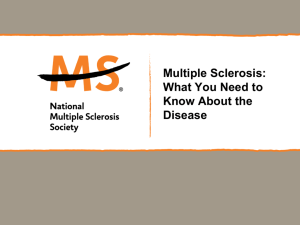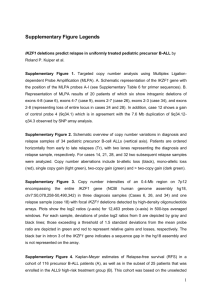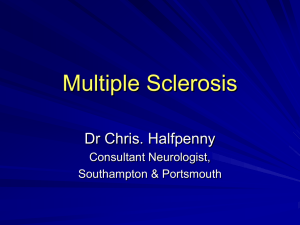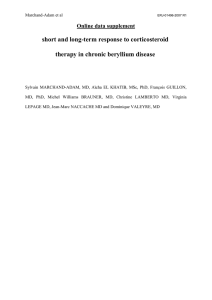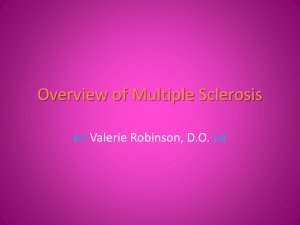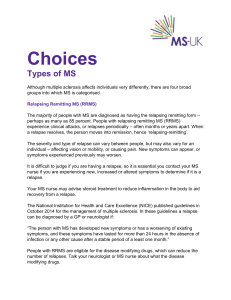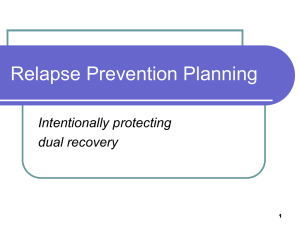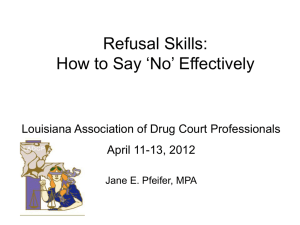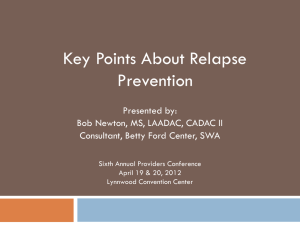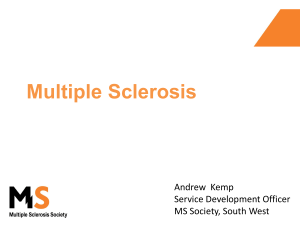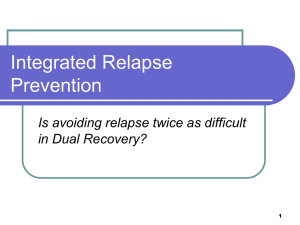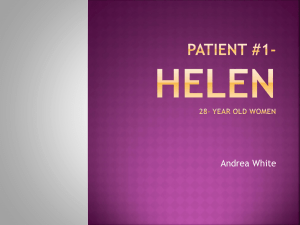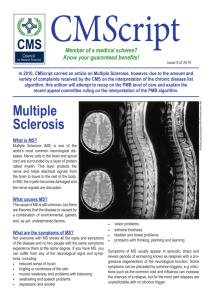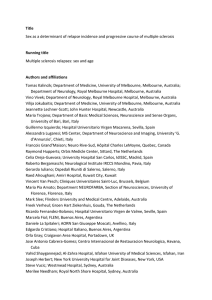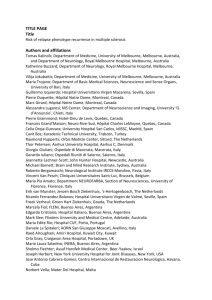MS Review - University of Calgary
advertisement
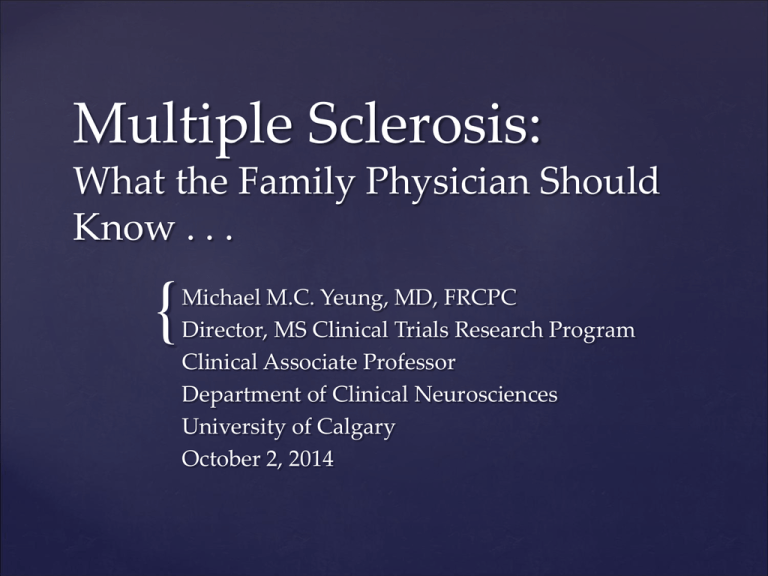
Multiple Sclerosis:
What the Family Physician Should
Know . . .
{
Michael M.C. Yeung, MD, FRCPC
Director, MS Clinical Trials Research Program
Clinical Associate Professor
Department of Clinical Neurosciences
University of Calgary
October 2, 2014
Research Support
Consultant
BiogenIdec, Novartis, EMD Serono, Bayer, Teva Canada
Innovation
Speakers’ Bureau
National Institutes of Health, MS Society of Canada,
BiogenIdec, Hoffman-LaRoche, Sanofi-Aventis, Novartis,
Elan, EMD Serono, Neuroscience Canada, IMPAX, Bayer,
Teva Canada Innovation, Genzyme, Acorda Therapeutics,
Berlex, BioMS Technology,
Protein Design Labs, Genentech, GSK, Abbott, Neurocrine
MS Society of Canada, BiogenIdec, Novartis, EMD Serono,
Bayer, Teva Canada Innovation
Honoraria
MS Society of Canada, BiogenIdec, EMD Serono, Bayer
Teva Canada Innovation
Disclosures
University of Calgary MS Clinic
When Should I Suspect Multiple Sclerosis?
Diagnostic Criteria
Is it a Relapse?
Disease Modifying Treatments
Symptom Management
Complementary & Alternative Treatments
Contents
Established in 1978 as part of
Canadian Network of MS Clinics
To provide specialized multi-disciplinary care
and treatment
To participate in clinical and investigatordriven research trials
University of Calgary
MS Clinic
~6000 registered patients
Foothills Medical Centre and South Health
Campus
9 neurologists, 1 physiatrist, 2 neuropsychiatrists
1 nurse practitioner, 4.5 clinic nurses, 2 special
therapies nurses, 1.5 research nurses
3 research coordinators, 3 research assistants, 4
health outcomes research assistants
University of Calgary
MS Clinic
Outpatient Treatment in Multiple Sclerosis
OT, PT, SW, psychology, bowel & bladder nurse
2 psychiatrists, 2 neuro-psychiatrists
Provides access to co-ordinated rehab services
Entry point is MS Clinic
OPTIMUS
Multidisciplinary Team Approach
Diagnose and confirm MS
Initiate and monitor disease modifying
therapies
Give recommendations for symptom
management
Initiate referral to rehabilitation services
Organize other community support
Offer eligible patients the opportunity to
participate in clinical trials
What the Clinic Can Do
Provide emergency care
Manage primary care needs
Initiate non-evidence-based treatments
Manage patients without a primary care
provider
Provide services under the mandates of other
programs
What We Cannot Do
What is MS?
Auto-immune disorder of CNS
Genetic predisposition
Inflammation
Axonal degeneration
Caucasian
Environmental trigger
Unknown
What is MS?
Epidemiology
MS is the most common neurological disorder
affecting young adults in Canada
More common in females (2 - 3:1)
~50,000 people with MS in Canada
Prevalence 1:500 - 1:1000
Alberta prevalence 1:300
Epidemiology
When Should MS be in the
Differential Diagnosis?
Common Presentations
Visual
Motor
Progressive myelopathy
Incomplete transverse myelitis
Sensory
Optic neuritis
INO
Lhermitte’s
Incomplete transverse myelitis
Coordination
Ataxia
Gait
Common Presentations
Unusual Presentations
Pain
Paroxysmal symptoms
Migratory transient paresthesias
Movement disorders
Seizures
Peripheral neuropathy
Unusual Presentations
Structural lesions of brain or spinal cord
Cerebral vasculitis
Autoimmune diseases
Metabolic diseases
Sarcoidosis
Lupus
Vitamin B12 deficiency
Infections
Lyme disease
Differential Diagnosis of
MS
Barkhof’s MRI Criteria
Gd-enhancing
T2-hyperintense
Infratentorial
Spinal
Cord
Juxtacortical
Periventricular
Differential Diagnosis of
MRI White Matter Lesions
Aging
Migraines
Hypertension
Trauma
Radiation therapy
Chronic fatigue syndrome
Cocaine addiction
CADASIL
Differential Diagnosis of
MRI White Matter Lesions
CBC & differential
LFTs & renal function
Electrolytes, glucose, Ca, Mg, PO4
Vitamin D level
Serum protein electrophoresis
Vitamin B12 level
RF, ANA
VDRL
MRI brain and cervical spinal cord +/- contrast
Work-up
2010 revised McDonald criteria
Neurological symptoms and/or signs
separated in time and space
MRI can help in diagnosis, but is not THE
diagnostic test
Diagnostic Criteria
MS: Clinical Subtypes
Four established clinical courses differ by the time course of
relapse and progression
Relapsing-Remitting MS (RRMS)
Secondary Progressive MS (SPMS)
Primary Progressive MS (PPMS)
Progressive Relapsing MS (PRMS)
Goodin DS, et al. Neurology. 2002;58:169-178. Craig J, et al. J Neurol Neurosurg Psychiatry. 2003;74:1225-1230.
Relapsing-Remitting MS
Increasing
Disability
Increasing
Disability
No disease progression between relapses
Time
Acute relapses with full recovery
Lublin FD, Reingold SC. Neurology. 1996;46:907-911.
Time
Acute relapses with
sequelae and residual deficit
upon recovery
Secondary Progressive MS
Increasing
Disability
Increasing
Disability
Patients with an initial RRMS course convert to SPMS, which is
characterized by continuous progression
Time
Time
Without relapses
With relapses
Lublin FD, Reingold SC. Neurology. 1996;46:907-911.
Primary Progressive MS
Increasing
Disability
Increasing
Disability
PPMS is characterized by progression of disability from onset
Time
Without plateaus or remissions
Lublin FD, Reingold SC. Neurology. 1996;46:907-911.
Time
With occasional plateaus and
temporary minor improvements
Progressive Relapsing MS
Increasing
Disability
Increasing
Disability
PRMS is characterized by disease progression from onset with
the occurrence of clear acute relapses
Time
Full recovery following relapse
with progression between
relapses
Lublin FD, Reingold SC. Neurology. 1996;46:907-911.
Time
Without full recovery
following relapse with
progression between relapses
About 80%–85% of all MS patients initially have RRMS;
most will convert to SPMS in 6-10 years
(N =
3019)
Clinical Subtypes (at
Presentation)
Jacobs LD, et al. Mult Scler. 1999;5:369-376.
Education and support
Optimize overall wellness
Relapse identification and treatment
Symptom management
Disease modifying therapies
MS Treatment
Wellness
Healthy and balanced diet
Regular exercise
Smoking cessation
Avoid excessive caffeine & alcohol
Routine screening medical exams and attention
to other medical conditions
Recognition and treatment of depression
Manage stress
Vitamin D3 4000 IU/day
Vaccinations (avoid live attenuated vaccines)
Wellness
Vitamin D
Adapted from Hollis et al., CMAJ 2006
Vitamin D
Adapted from Mora et al., Nature Reviews immunology 2009
Relapse vs Pseudo-relapse
vs Fluctuation
30-yr-old woman with RRMS for 3 years, on a
DMT, calls the Clinic. Over the last 3 days, she
has noted pain in the L eye with some visual
blurring, worse at the end of day. Colours
seem less bright. Her last relapse (Lhermitte’s
with numbness of her R arm) was ~2 years ago
prior to starting her DMT.
What would you do?
Case Mrs. RR
“a focal disturbance of function, affecting a
white matter tract, lasting for more than 24
hours. Typically, tends to progress over a
period of a few days, reaching a maximum in
less than 1 week and then slowly resolving.”
Schumacher
“occurrence of a symptom or symptoms of
neurological dysfunction, in the absence of
fever, with or without objective confirmation,
lasting more than 24 hours.”
Clinical trials
What is a relapse?
Recurrence of old symptoms
Short duration
Accompanying metabolic or toxic change
Disappearance of symptoms and signs when
aggravating metabolic change has been
corrected
What is a pseudo-relapse?
Changing neurological function throughout
day.
What are fluctuations?
Lhermitte’s phenomenon/symptom
Uhthoff’s phenomenon/symptom
Multiple tonic spasms over 24 hours
Trigeminal neuralgia
Dragging foot after shopping for 20 minutes;
better after having coffee and éclair
Increased leg weakness with recent URTI
Numbness to waist lasting 3 weeks
Relapse/pseudorelapse/fluctuation?
To Treat or Not to Treat?
Interferons
Betaseron®
Extavia®
Rebif®
Avonex®
Glatiramer acetate (Copaxone®)
Natalizumab (Tysabri®)
Fingolimod (Gilenya®)
Dimethyl fumarate (Tecfidera®)
Teriflunomide (Aubagio®)
Alemtuzumab (Lemtrada®)
Disease Modifying
Therapies
Seems to protect from relapses (2nd & 3rd
trimester); likely related to hormone levels
Fertility treatments may increase risk of relapse
Increased relapse rate during 1st trimester postpartum
First-line injectable DMTs (GA, IFN-β)
considered safe in breast-feeding
Pregnancy
Symptom Management
Sources of Symptoms
Symptoms vary widely in incidence and
severity
Cognitive loss
Emotional disinhibition
Tremor,
Ataxia
Sensory symptoms,
Lhermitte’s
Pain
Proprioception
Optic neuritis
Diplopia
Vertigo
Dysarthria
INO
Bladder dysfunction
Spasticity
Tremor & ataxia
Fatigue
Sensory symptoms
Bowel and bladder
Sexual dysfunction
Cognitive impairment
Symptoms
Complementary &
Alternative Treatments
Neurologycare.net
Naturaldatabase.com
CAM Websites
There is no specific diagnostic test (imaging,
blood, CSF) for MS
There is a differential diagnosis for white
matter lesions on MRI
Neurological symptoms in MS patients are not
always related to MS activity
MS patients can develop other diseases that
may impact their MS symptoms
Take Home
Exacerbations do not necessarily require
treatment with corticosteroids
There is NO role for low dose corticosteroids in
the treatment of MS relapses
Treatment of symptoms will improve quality of
life
Take Home
Thank you!
